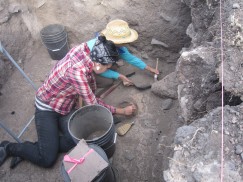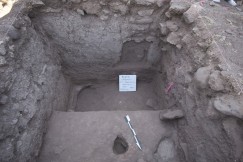- Home
- >
- Preservation Archaeology Blog
- >
- …And More Questions Raised!
 |
By Katherine A. Dungan, Research Assistant
|

In my last post, I described three goals for our research at Fornholt this year. In this post, I’ll discuss the second of these goals.
Last year, in the two-story part of the southern room block, we found a burned storage room filled with the carbonized remains of corncobs. This year, we hoped to learn whether there was additional evidence for burned storerooms elsewhere in the southern room block. To this end, we placed an excavation unit in a room corner in the western part of the southern room block. The mound is very tall in this area, and we thought that this would be a good place to look for another two-story room with a lower story that might have been used for storage. Danny Welch, a Ph.D. student at Texas A&M, supervised the excavations in this area, and our students did an excellent job of excavating some very tricky contexts.
What we found surprised us, and raised some interesting questions about just how long people stayed at this site. When we began digging in this area, we found a surprising amount of trash and dumps of ash (probably from cleaning out hearths) filling the room, and then we discovered a beautifully preserved floor a bit more than a meter below the ground surface. This room was remodeled at some point by filling in a doorway with masonry and plaster. The room must have burned before being filled with trash, because we found the bottom of a large burned post still in its posthole. Unlike last year’s burned room, however, there’s no evidence of burned corn or beans here.
When we dug below this floor, we discovered several earlier floors, which are the remains of a succession of remodeling episodes. Even more interesting is the fact that, below the level of the latest floor, the room walls appear to be made of adobe, rather than the masonry that we see at the site surface.

This room really changes how we’ve (or at least I’ve) been thinking about the length of time over which this site was built. Last year, only one of the rooms in which we excavated had any evidence of remodeling. In this room, we seem to be looking at an early occupation using adobe walls. Sometime later, masonry walls were built up from that adobe base. During the time that the masonry room was in use, the doorway was sealed. The room was at least partially burned, and finally was filled with trash. Taken together, this suggests that people were at the site for quite a long time (or at least came back to the site several times). Perhaps this western section of the southern room block was the founding occupation at the site, and the rest of the rooms were slowly added around it. I had been thinking that the Fornholt site might have been something like a short-lived experiment—the Gila Cliff Dwellings, one of the few other Tularosa Phase sites this far south, was built in the 1280s, and people seem to have lived there for only a generation or two. It now looks as if Fornholt’s residents had deeper roots in the area than I first thought. We’re still in the speculative stage, though, and will need to spend more time in the field and lab to better understand what’s going on in this room.
The next time I post, I’ll talk about our efforts to get to the bottom—figuratively and literally—of the apparent great kiva in the southern room block. In the meantime, stay tuned for more student posts as we enter the last two weeks of the field school.
Explore the News
-
Join Today
Keep up with the latest discoveries in southwestern archaeology. Join today, and receive Archaeology Southwest Magazine, among other member benefits.